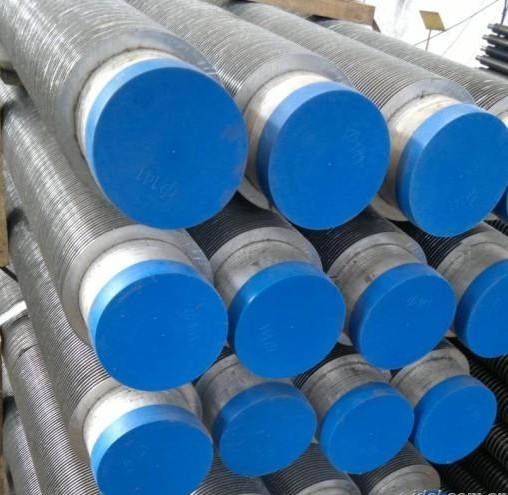SA335 P11 SS409 HFW Finned Pipe
The SA335 P11 SS409 HFW (High-Frequency Welded) Finned Pipe combines a high-temperature-resistant SA335 P11 chromium-molybdenum alloy steel base pipe with corrosion-resistant SS409 stainless steel fins, utilizing advanced high-frequency welding technology to create a durable, efficient heat transfer solution for power plants, petrochemical systems, and industrial boilers operating under extreme temperatures (up to 540°C) and corrosive environments.
1. HFW SA335 P11 Fin Pipe Overview
High-Frequency Welded Finned Tubes are high-efficiency heat exchange components where metal fins are securely welded to the outer surface of a base pipe through high-frequency induction welding technology. Their core function is to significantly increase heat transfer surface area, improving thermal conduction efficiency for applications in high-temperature, high-pressure, and corrosive environments.
- Power Industry: Boiler economizers, superheaters, air preheaters
- Petrochemical: Reboilers, condensers, catalytic cracking units
- Environmental Engineering: Waste heat recovery, flue gas desulfurization systems
- Industrial Boilers: Waste heat boilers, gas turbine heat exchange modules
2. Analysis of Base Pipe Material SA335 P11
2.1 Material Standard and Chemical Composition
- Standard: ASTM SA335 (Seamless Ferritic Alloy-Steel Pipe for High-Temperature Service)
- Grade Equivalent: P11 (Similar to Chinese 15CrMoG, German 13CrMo4-5)
| Chemical Composition (wt%) | ||||||
|---|---|---|---|---|---|---|
| Element | C | Mn | Si | Cr | Mo | P/S |
| Range | 0.05~0.15 | 0.30~0.60 | 0.50~1.00 | 1.00~1.50 | 0.44~0.65 | ≤0.025 |
2.2 Mechanical Properties and High-Temperature Characteristics
- Room Temperature Mechanical Properties:
- Tensile Strength (σb): ≥415 MPa
- Yield Strength (σs): ≥205 MPa
- Elongation (δ): ≥30%
- High-Temperature Creep Strength (at 550°C):
- 100,000-hour rupture strength: ≥80 MPa
- Heat Treatment Process: Normalization + Tempering (Typically 930°C normalization, 650°C tempering)
2.3 Corrosion Resistance and Welding Properties
- Oxidation Resistance: Forms stable Cr₂O₃ protective film below 540°C
- Welding Key Points:
- Preheat to 200~300°C (to prevent cold cracking)
- Recommended welding material: E8018-B2 (AWS standard)
3. Comprehensive Analysis of Fin Material SS409
3.1 Material Characteristics and Composition
- Standard Equivalent: ASTM A240 (UNS S40900), ferritic stainless steel
| Chemical Composition (wt%) | |||||
|---|---|---|---|---|---|
| Element | C | Cr | Ti | Mn | Si |
| Range | ≤0.08 | 10.5~11.7 | 6×C~0.75 | ≤1.0 | ≤1.0 |
3.2 Corrosion Resistance and Thermal Stability
- Corrosion Resistance:
- Better atmospheric corrosion resistance than carbon steel, but weaker than austenitic stainless steel
- In sulfur-containing environments (e.g., flue gas dew point corrosion), temperature should be controlled ≤400°C
- High-Temperature Performance:
- Continuous service temperature: -20~650°C
- Oxidation limit: 800°C (short-term)
3.3 Fin Forming Process
- Processing Method: Cold rolling (fin height up to 16mm, pitch 3~8mm)
- Surface Treatment: Sandblasting or pickling passivation can be applied to enhance corrosion resistance
4. Technical Details of High-Frequency Welding Process
4.1 Welding Principle
High-frequency current (100~400kHz) generates skin effect at the contact surface between the fin root and base pipe, instantly heating to 1200~1300°C to achieve metallurgical bonding without filler material.
4.2 Process Advantages
- Small heat-affected zone (≤1mm), preventing base pipe performance degradation
- High welding speed (up to 20m/min)
- Bonding strength: Shear strength ≥200 MPa
4.3 Quality Inspection
- Non-destructive testing: Eddy current testing (ET) + Ultrasonic testing (UT)
- Metallographic examination: Welds must be free from defects like lack of fusion or porosity
5. Parameters for Engineering Selection
| Parameter | Design Requirements | Typical Example |
|---|---|---|
| Base Pipe Dimensions | OD × Wall Thickness | Φ38×4mm |
| Fin Height | Heat transfer efficiency vs. pressure drop balance | 12mm |
| Fin Thickness | Wear resistance requirements | 0.8mm |
| Fin Pitch | Anti-fouling design | 5mm |
| Working Pressure | Calculated per ASME B31.3 | 6.4MPa |
| Design Temperature | Material upper limit | 540°C |
6. Solutions for Special Operating Conditions
- High-sulfur environments: Recommend internal cladding with Alloy 625
- Chloride corrosion: Switch to duplex stainless steel fins (e.g., S31803)
- Severe wear scenarios: Apply tungsten carbide coating on fin surface
The SA335 P11 + SS409 combination represents a balanced solution of economy and reliability, suitable for over 80% of industrial heat exchange applications. For extreme conditions, we recommend material upgrades coupled with numerical simulation optimization for comprehensive design solutions. Providing complete operating parameter tables (medium composition/temperature profile/flow rate) enables further technical customization.

SA335 P11 SS409 HFW Finned Pipe

